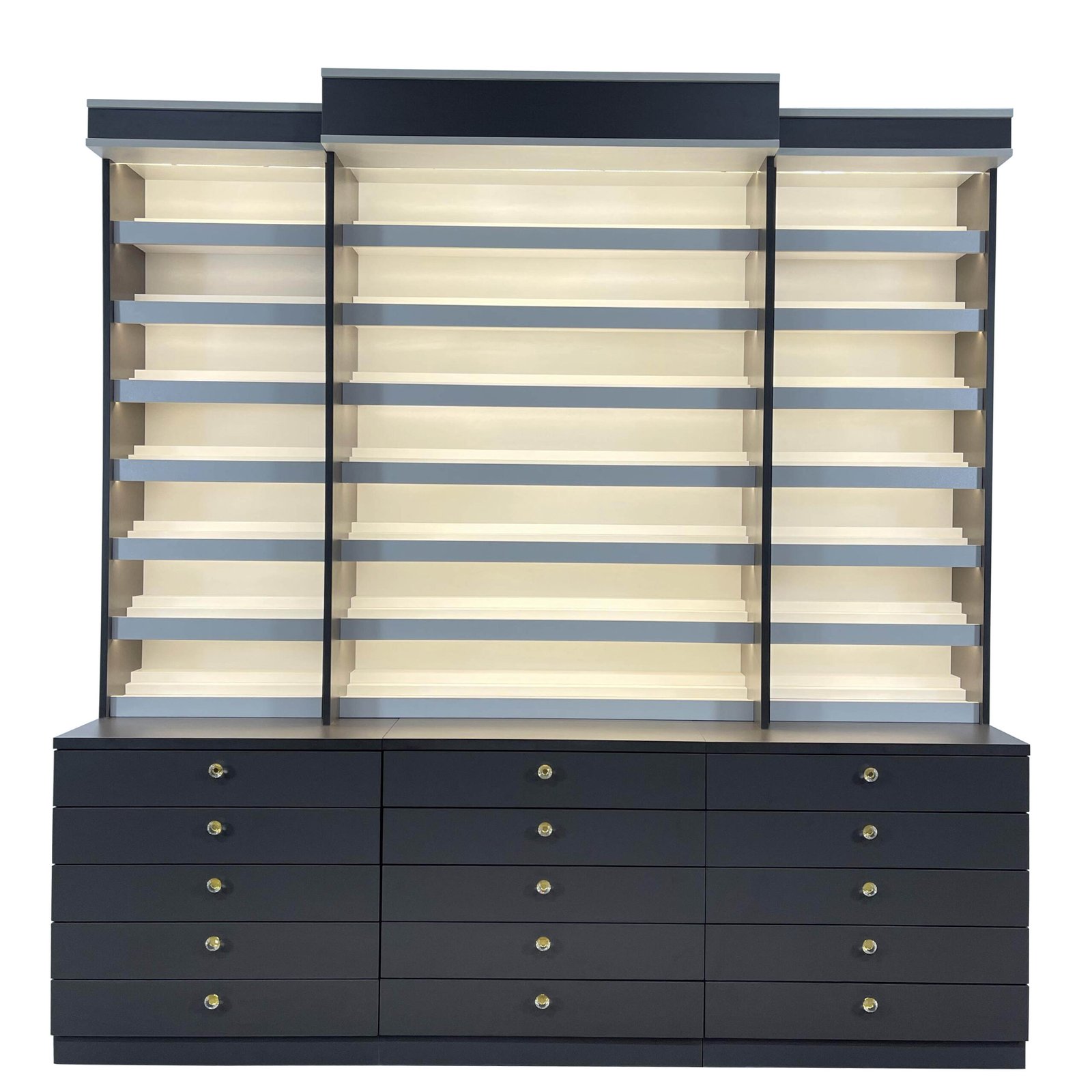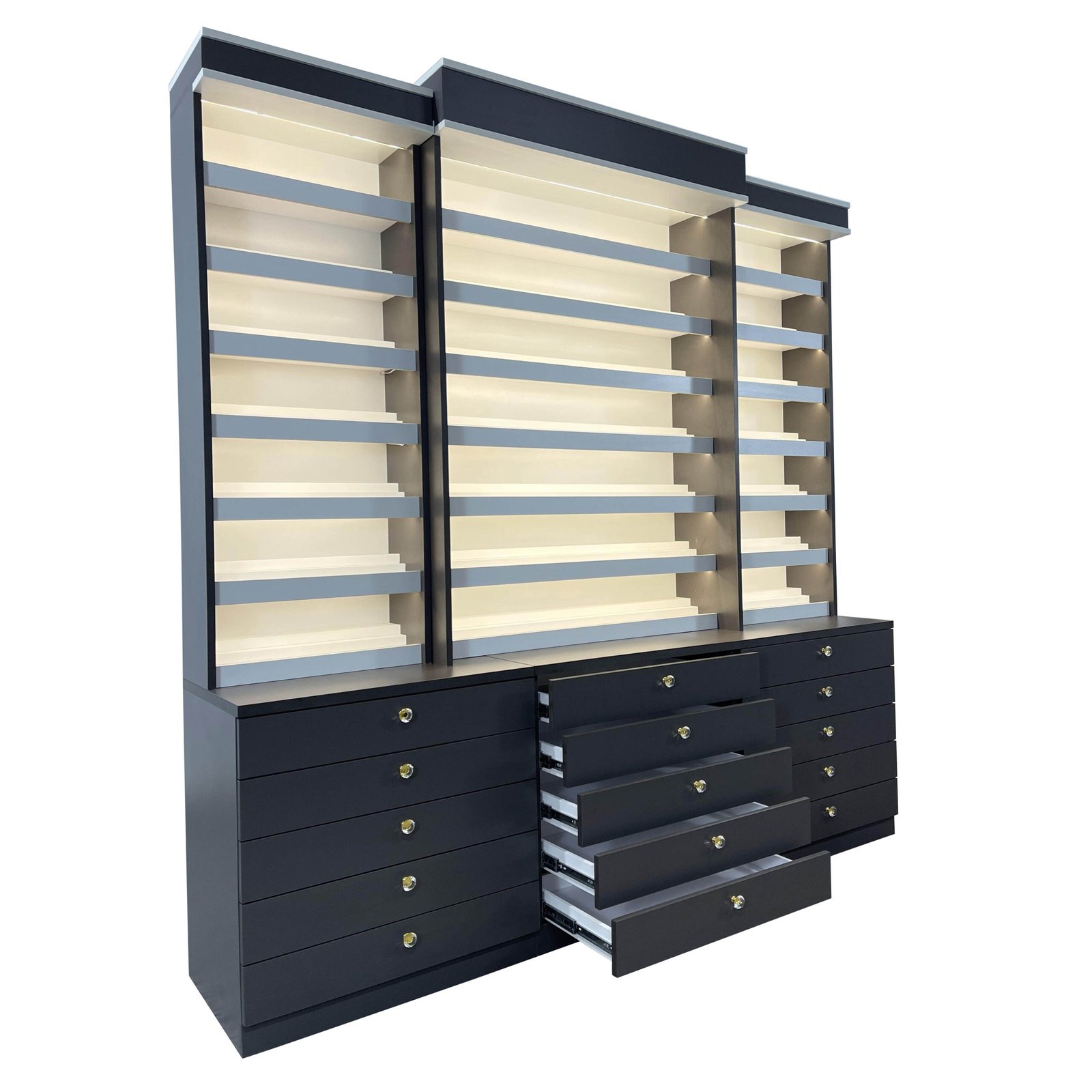Nail Polish Cabinet Designs & Features

Choosing the right nail polish cabinet can significantly improve your organization and enhance your beauty routine. This section explores various designs, materials, and organizational features to help you select the perfect cabinet for your needs.
Nail Polish Cabinet Designs
Five distinct nail polish cabinet designs, each offering unique storage solutions and aesthetic appeal, are detailed below. Consider your space, storage needs, and personal style when making your selection.
- Classic Freestanding Cabinet (30″W x 15″D x 60″H): This design features a tall, freestanding structure with hinged doors, offering ample shelf space for a large collection. The dimensions provide substantial storage, suitable for even extensive collections. Internal adjustable shelving allows customization to accommodate different bottle sizes.
- Slimline Wall-Mounted Cabinet (12″W x 5″D x 36″H): Ideal for smaller spaces, this cabinet maximizes vertical space. Its slim profile minimizes floor space usage. Hinged doors provide easy access, and narrow shelves optimize storage for a moderate collection.
- Rolling Cart Cabinet (18″W x 12″D x 30″H): This mobile cabinet offers flexibility, allowing you to move it easily between different areas. Drawers and shelves provide varied storage options. The rolling cart is especially useful for those who frequently use their nail polish collection.
- Drawer-Style Cabinet (24″W x 16″D x 20″H): This cabinet prioritizes drawers for organized storage. Each drawer can be dedicated to a specific nail polish type or color family. The design is compact, yet surprisingly spacious for its footprint.
- Corner Cabinet (24″W x 24″D x 72″H): Perfect for utilizing awkward corner spaces, this cabinet maximizes storage in a limited area. Its tall design and multiple shelves provide extensive storage capacity for large nail polish collections. The unique shape allows efficient use of often-wasted space.
Material Comparison for Nail Polish Cabinets
The choice of material significantly impacts the cabinet’s durability, aesthetics, and price.
Wood, acrylic, and metal each offer distinct advantages and disadvantages:
- Wood: Offers a classic, elegant look. Durable and long-lasting, but can be more expensive than other options and may require more maintenance to prevent damage from moisture.
- Acrylic: Lightweight and relatively inexpensive. Easy to clean and maintain. However, acrylic can be less durable than wood and may scratch more easily.
- Metal: Very durable and resistant to damage. Offers a modern, sleek look. However, metal can be more expensive than acrylic and may be susceptible to rust if not properly treated.
Door Mechanisms for Nail Polish Cabinets
The type of door mechanism influences accessibility and aesthetics.
| Type | Pros | Cons | Suitability |
|---|---|---|---|
| Hinged Doors | Traditional, easy to install, provides full access | Requires sufficient clearance to open fully | Most cabinet designs, especially freestanding and wall-mounted |
| Sliding Doors | Space-saving, ideal for tight spaces | Can be more difficult to install, may not provide as much access as hinged doors | Slimline cabinets, cabinets in tight spaces |
| French Doors | Elegant, provides wide access | More expensive than hinged doors, requires more space | Larger cabinets where space is not a constraint |
Interior Organization of Nail Polish Cabinets
Efficient interior organization is crucial for maximizing storage and easy access to your nail polish collection.
Several methods enhance organization:
- Adjustable Shelves: Allow customization to accommodate different bottle sizes and shapes. This maximizes space utilization and prevents wasted space.
- Drawers: Ideal for storing smaller items like nail art supplies or smaller polish bottles. Drawers offer a contained and organized storage solution.
- Dividers: Keep bottles upright and prevent them from tipping over. Dividers can be added to shelves or drawers for better organization.
- Rotating Trays: Allow easy access to polishes stored in the back. This is particularly useful for larger collections.
Shopping Guide for Nail Polish Cabinets: Nail Polish Cabinet With Door

Choosing the right nail polish cabinet can transform your beauty routine from chaotic to chic. A well-organized collection not only looks great but also makes finding your favorite shades a breeze. This guide will help you navigate the options and find the perfect cabinet for your needs.
Key Factors to Consider When Purchasing a Nail Polish Cabinet
Selecting a nail polish cabinet involves careful consideration of several crucial factors to ensure you get the best value and functionality for your needs. Ignoring these factors could lead to disappointment later.
- Size: Measure your available space and consider the size of your current nail polish collection. Allow for future growth to avoid outgrowing your cabinet too quickly. Consider both the cabinet’s external dimensions and the internal shelving space.
- Material: Common materials include wood, MDF (medium-density fiberboard), and plastic. Wood offers a more luxurious look and durability, while MDF is a more budget-friendly option. Plastic cabinets are lightweight and easy to clean but might not be as durable.
- Price: Nail polish cabinets range in price from budget-friendly to high-end. Set a realistic budget before you start shopping to avoid overspending. Consider the features and material in relation to the price to ensure you’re getting good value.
- Features: Think about features like adjustable shelves, lighting (LED is energy-efficient), locking doors for security, and the number of shelves or drawers. Consider whether you need additional features like a mirror or built-in organizers.
- Style: Choose a style that complements your existing décor. Cabinets come in various styles, from sleek and modern to rustic and vintage. Consider the overall aesthetic of your space and select a cabinet that blends seamlessly.
Nail Polish Cabinet Comparison Chart
This chart compares four hypothetical nail polish cabinets to illustrate the range of options available. Remember to check current pricing and availability on retailer websites.
| Brand | Model | Features | Price (USD) |
|---|---|---|---|
| Glamour Glaze | GG-100 | Wooden construction, adjustable shelves, LED lighting, lockable door | $150 |
| Polish Paradise | PP-50 | MDF construction, fixed shelves, no lighting, no lock | $75 |
| Lacquer Luxe | LL-200 | Acrylic construction, multiple drawers, UV protection, lockable door | $200 |
| Color Craze | CC-150 | Metal frame with glass doors, adjustable shelves, built-in mirror | $175 |
Step-by-Step Guide to Assembling a Nail Polish Cabinet
Assembling your new nail polish cabinet is often straightforward, but following these steps ensures a smooth process. Always refer to the manufacturer’s instructions as they may vary slightly.
- Gather Tools and Materials: You’ll likely need a screwdriver (Phillips and flathead), a hammer (sometimes), and possibly a level. Check your cabinet’s instructions for a complete list.
- Safety Precautions: Wear safety glasses to protect your eyes from flying debris. Work in a well-lit area and keep children and pets away.
- Follow the Instructions: Carefully read and follow the manufacturer’s assembly instructions step-by-step. Take your time and don’t rush the process.
- Attach the Shelves: Most cabinets require attaching shelves to the sides or back panels. Ensure they are level and securely fastened.
- Install the Door: Carefully attach the door hinges and handle according to the instructions. Ensure the door opens and closes smoothly.
- Final Check: Once assembled, inspect the cabinet for any loose parts or damage. Ensure all shelves are stable and the door functions correctly.
Tips for Maintaining and Cleaning a Nail Polish Cabinet
Proper maintenance extends the life of your cabinet and protects your nail polish collection.
- Regular Dusting: Regularly dust the cabinet to prevent the accumulation of dirt and debris. Use a soft cloth or duster to avoid scratching the surface.
- Spot Cleaning: For spills or stains, clean them immediately with a damp cloth and mild detergent. Avoid harsh chemicals that could damage the finish.
- Organize Regularly: Maintain an organized interior to prevent polishes from tipping over or getting damaged. Periodically check for expired polishes and discard them appropriately.
Creative Uses & Styling Ideas

A nail polish cabinet with a door offers more than just storage; it’s a versatile piece of furniture that can enhance your home’s aesthetic and organization. With a little creativity, you can transform it into a stylish and functional addition to any room. Let’s explore some inspiring ideas to maximize its potential.
Styling a Nail Polish Cabinet in Different Room Settings
The beauty of a nail polish cabinet lies in its adaptability. Its design allows for seamless integration into various spaces, enhancing the overall decor.
- Bedroom Setting: Imagine a sleek white nail polish cabinet nestled on a vanity table in a minimalist bedroom. The cabinet’s clean lines complement the room’s understated elegance. Surrounding it, you might find a delicate floral arrangement, a small mirror with an ornate frame, and a few carefully chosen scented candles. The overall effect is one of calm sophistication.
- Bathroom Setting: In a spa-like bathroom, a dark wood nail polish cabinet with brushed gold hardware adds a touch of luxurious warmth. Placed on a countertop near the sink, it’s conveniently accessible. Towels in coordinating shades, a fluffy bathmat, and decorative soap dispensers create a cohesive and inviting atmosphere.
- Vanity Area Setting: A brightly colored nail polish cabinet, perhaps a cheerful turquoise or sunny yellow, could be the focal point of a vibrant vanity area. Positioned against a patterned wallpaper, the cabinet’s bold color pops. Adding a collection of vintage perfume bottles, sparkling jewelry dishes, and a glamorous mirror creates a playful yet refined aesthetic.
Creative Uses Beyond Nail Polish Storage, Nail polish cabinet with door
The compact size and customizable interior of a nail polish cabinet make it perfect for storing various items beyond nail polish.
- Craft Supplies: Organize small craft items like beads, buttons, and embellishments. The cabinet’s drawers and shelves keep everything neatly contained and easily accessible, preventing clutter on your workspace.
- Jewelry Storage: Use the cabinet to store necklaces, earrings, and bracelets. Small compartments or dividers can help prevent tangling and keep jewelry organized by type or style. This provides a secure and stylish alternative to a traditional jewelry box.
- Small Cosmetics: Store lipsticks, eyeshadow palettes, and other small makeup items. The cabinet’s clear view allows you to easily locate specific products, saving time and frustration during your morning routine.
- Essential Oils and Fragrances: Organize your collection of essential oils and perfumes. The cabinet’s enclosed design helps to protect the fragrances from light and air, preserving their quality for longer.
- Medication Storage: Store over-the-counter medications and first-aid supplies. The cabinet’s enclosed design and organized compartments help keep these items safe, secure, and easily accessible in case of an emergency.
Rewritten Nail Polish Cabinet Organization Article
[Insert rewritten article text here. This section requires the original article text to be provided for rewriting. The rewrite should focus on clear, concise language, avoiding overly technical or robotic phrasing. It should sound like it was written by a human expert rather than an AI.]
Creating a Visually Appealing Nail Polish Display
A well-organized and visually appealing nail polish display transforms a simple cabinet into a stylish statement.
Nail polish cabinet with door – Consider these techniques to elevate your nail polish presentation:
- Color Coordination: Arrange polishes by color family (reds, pinks, purples, etc.) or by creating a rainbow effect. This creates a pleasing visual harmony and makes it easy to find the shade you need.
- Organization by Brand or Type: Grouping polishes by brand or type (cremes, shimmers, glitters) adds a level of sophistication and makes browsing your collection more efficient. Consider using small labels to identify each section.
- Use of Decorative Elements: Add small decorative elements such as miniature plants, decorative trays, or small mirrors to add visual interest and break up large blocks of color. Consider using drawer liners or shelf organizers in complementary colors or patterns.
